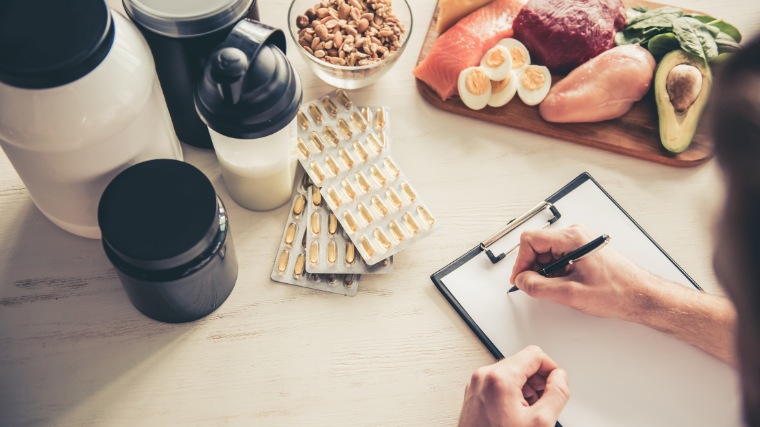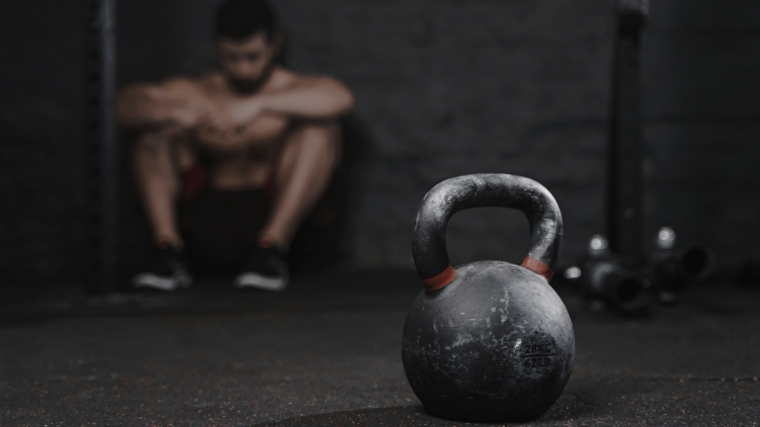Nutritional trends rise and fall in the fitness industry. It’s easy to get caught up in the current or enamored with the hype of a dietary trend — even if said idea doesn’t stand up to scientific scrutiny.
Conventional wisdom in bodybuilding suggests (for better or worse) that if you want to get big, you’ve got to eat big. While the “dirty bulk” may work for individuals who have to toil on end in the kitchen just to see the scale move, it certainly isn’t a necessity for everyone looking to improve the quality of their physique, or their performance in the weight room.

Here’s what you need to know about dirty bulking so you can make an informed decision about your approach to healthy and sustainable weight gain.
Dirty Bulking Explained
- What Is Dirty Bulking?
- Benefits of Dirty Bulking
- Drawbacks of Dirty Bulking
- Who Should Try Dirty Bulking
Editor’s Note: The content on BarBend is meant to be informative in nature, but it should not be taken as medical advice. When starting a new training regimen and/or diet, it is always a good idea to consult with a trusted medical professional. We are not a medical resource. The opinions and articles on this site are not intended for use as diagnosis, prevention, and/or treatment of health problems. They are not substitutes for consulting a qualified medical professional.
What Is Dirty Bulking?
As a slang term, “bulking” generally refers to a specific period in which a physique-minded gymgoer intentionally overeats in an attempt to add muscle to their frame.
This is most commonly achieved through combining consistent resistance training sessions with a calculated, well-thought-out caloric surplus.
Dirty bulking refers to the practice of eliminating a set caloric goal for the day and instead opting to consume as much food as possible. It’s sometimes jokingly referred to as a “see-food” diet.
Bodybuilders utilize dirty bulks as an extreme method of ensuring that they ingest adequate calories and macronutrients to fuel their training and enable muscular hypertrophy.
This practice tends to be accompanied by significant gains in both scale weight and body fat as well.
What Dirty Bulking Is NOT
Before you continue, understand that despite the connotations associated with the name, dirty bulking has nothing to do with the quality of the food you eat.
Viewing foods through a binary lens as either “clean” or “dirty” based on a vague perception of quality isn’t practical or supported by the scientific community.
It’s certainly true that some foods are more nutritionally-dense than others, but your dietary needs should contextualize your food choices; not the other way around.
Dirty bulks are characterized by the quantity of food eaten, not the quality of those foods.
What the Science Says
The principles of muscular hypertrophy — and basic thermodynamics — confirm the idea that, in most cases, you’ll need a caloric surplus in order to put on muscle. This means eating more calories than you burn for an extended period of time. However, there is an efficacy ceiling here, and more isn’t always more. (1)
Chronic overeating will almost always lead to weight gain, though research has yet to firmly decide exactly how large of an energy surplus is “optimal” for muscle growth, and how much your intake beyond said threshold could be considered redundant. (2)
For those who partake in proper resistance training, weight gain will consist of both muscle and fat depending on the magnitude of your caloric surplus, mostly irrespective of what macronutrients you consume in what proportions. (3) You won’t be able to overfeed yourself by a thousand calories a day of just protein and “cheat” the risks of fat gain.

Clinical research on trained subjects who dirty bulk is scant, but some literature has observed the effects of unchecked overfeeding as part of a bulking regime.
At present, studies suggest that while large caloric surpluses will help add scale weight, you aren’t likely to put on any more muscle than someone who took a moderated approach to their bulk. (4)
Further, other literature has actually demonstrated that “guided” bulks with proper supervision from a professional and controlled adherence from the subject resulted in more muscle gain than a no-holds-barred bulking diet. (5)
The body of evidence around the practice isn’t exactly comprehensive, but at present, dirty bulking does not appear to be any more effective at creating muscle gain than a diet with a set caloric surplus.
Benefits of Dirty Bulking
Even if dirty bulking does appear to lack strong science-based support, there is still some merit to it as a practice. That said, the more extreme a diet or meal plan appears, the more closely you should scrutinize it to make sure it’s actually relevant to your needs.
Covers Your Bases
The primary purpose of dirty bulking is to guarantee, beyond a shadow of a doubt, that you’re eating enough to gain weight.
However, those with naturally low appetites may end up undereating if they don’t have a structured plan to adhere to — even if the goal is to consume as much as possible.

Still, going out of your way to put down as many calories as possible on a daily basis will generally ensure that you’re consuming enough calories and protein to facilitate hypertrophy, and enough carbohydrate to fuel your workouts.
This can make dirty bulking a viable “nuclear option” for athletes who seemingly struggle to put on weight no matter how closely they follow a scripted hypercaloric nutrition plan, as long as you’re willing to eat when you aren’t hungry.
Less Time Investment, Maybe
Any dietary approach that doesn’t involve tracking your intake, prepping meals from scratch, or weighing your portions will save you time. Note that you technically can monitor these things on a dirty bulk, but it isn’t a requirement.
Dirty bulking is also permissive of processed, frozen, or pre-packaged foods, which take less time and effort to prepare than making a balanced meal yourself at home.
Less time spent prepping meals in the kitchen may be offset by the time investment of consuming multiple additional meals, though. Especially if you have to trudge through a big plate of something you don’t want to put down in the first place.
More Tasty Meals
Taste is subjective, but the boundless nature of dirty bulking does allow you to indulge in just about whatever you want, as often as you want.
Foods high in sugar and fat tend to be more palatable and tempting. (6) Dirty bulking places no restrictions on what, or how much, you consume on a daily basis. While this is likely to be detrimental physiologically in some cases, it is worth mentioning.
Potential Strength Gain
Building strength is more about refining your body’s neural efficiency than it is about eating a lot. A high-calorie diet is important for fueling long and intense workouts, but strength is a skill you develop, not necessarily a mouth to feed.
That said, dirty bulking may also indirectly facilitate strength gain. All other factors kept equal, athletes with larger bodies are generally stronger than smaller ones. There’s a measurable symbiotic relationship between physical size and potential strength. (7)
However, while dirty bulking might help your absolute strength, significant weight gain could also diminish your relative strength; how much you can press, squat, or pull compared to how heavy you yourself are.
Thus, dirty bulking for strength purposes is something you’ll have to conduct your own cost-benefit analysis on.
Drawbacks of Dirty Bulking
The premise of eating as much as you like, as often as you like, and hitting the gym hard as a long-term dietary approach may sound alluring.
However, dirty bulking — while effective in some cases — is also likely to cause several detrimental health outcomes, no matter how hard you hit the iron.
Extra Fat Gain
Far and away the most prevalent consequence of an unchecked caloric surplus is the propensity for extra fat gain. Regularly taking in far more calories than you might burn will almost always result in a heavier number on the scale. (8)
Resistance training can help ensure that some of the weight you put on comes from lean tissue, but a large caloric surplus will cause you to gain more body fat over time as well. (9)

There are certainly exceptions, and extra fat gain isn’t an undesirable outcome for every athlete. However, dirty bulking does not provide you with the information required to observe how your caloric intake affects your rate of weight change.
Potential Health Issues
Devoted dirty bulking may incur some unwanted health outcomes, even if it does enable you to hit leg day harder than ever.
Chronic overfeeding and weight gain may be linked to increased incidence of depression in some people. (10) Stuffing your stomach on a daily basis may also make you feel bloated, sluggish, or even disrupt your sleep. (11)
Note that these health consequences are not causally linked to a hypercaloric diet, and that you aren’t necessarily doing bodily harm by eating everything in sight for a defined period.
Disordered Relationship With Food
Uninhibited overfeeding may negatively impact your personal relationship with food. There’s a difference between well-intentioned oversight and meticulously counting every single calorie, but chronic overfeeding can disrupt your body’s natural hunger and satiety signals. (12)
In practical terms, dirty bulks might make it harder for you to accurately self-assess your own satisfaction levels or inaccurately discern hunger from another feeling or impulse.
May Negatively Affect Performance
Eating more will generally enable you to train a bit harder for a bit longer, but this relationship isn’t linear.
Some athletes feel more comfortable in the gym on an empty stomach, while others flinch at the prospect of lifting heavy without eating a hearty meal beforehand.

Chronic overfeeding or consuming large meals with high glycemic loads can also play havoc with regulatory processes like blood sugar, depending on your body weight. (13) This can cause inconsistent “peaks and valleys” in your energy levels, mood, and alertness. Inconsistency is the last thing you want if you’re setting up for a new 1-rep max.
Who Should Try Dirty Bulking
Dirty bulking may be a well-recognized practice in bodybuilding circles, but don’t conflate that with it being a verified, legitimized, or endorsed practice. It may have some applicability depending on your particular needs, though.
Hardgainers, Maybe
There’s plenty of discourse in the fitness industry surrounding the proverbial “hardgainer” — the nondescript individual who, try as they may, simply cannot put on weight — but little science to back it up.
Certain metabolic disorders such as hyperthyroidism or Type-I diabetes are correlated with difficulty in gaining weight if left untreated. (14)(15) Assuming the person is in good standing with their health, the so-called hardgainer label tends to refer to people whose rate of weight change on the scale doesn’t properly correlate with the amount of calories they ingest.

Unfortunately, this phenomenon is not well-studied, particularly not in subjects who regularly lift weights or practice bodybuilding. If you find that your diet isn’t creating the weight change you’re after, a short-term dirty bulk might be a viable way to start packing on pounds.
However, there’s a fair chance that you may be lapsing in another area that could explain your stalling on the scale. Before diving into a dirty bulk, evaluate factors like your sleep quality, out-of-the-gym physical activity levels, and chronic stress.
These and more can hamper efforts to change body weight — even if you’re trying to gain instead of lose — and may be masked by the faulty supposition that you’re simply “not built to get big.”
Your Takeaways
Dirty bulking is a dietary approach characterized by eating as much food as possible on a daily basis.
Bodybuilders and performance-minded athletes will sometimes dirty bulk as an extreme method of guaranteeing that they’re eating enough calories and macronutrients to meet their goals.
The “dirty” moniker refers to the high quantity, unchecked number of calories consumed. It does not necessarily describe the nutritional quality of any individual food.
Dirty bulking may be a viable option for those who struggle to gain weight by conventional means, but it does come with some health and performance risks as well.
The existing body of scientific evidence does not support dirty bulking as being any more effective for adding muscle than a traditional hypercaloric diet.
The Big Picture
Dirty bulking is like fishing with dynamite. If you’re strongly invested in gaining weight it will usually get the job done, but there will likely be collateral damage. There’s no reason to take a sledgehammer to a process that could be accomplished just as well with a scalpel.
Most extreme dietary behaviors are inversely correlated with sustainability. Dirty bulking can rapidly effect change on the scale, but it probably shouldn’t be your long-term approach to performance nutrition.
If you’re aspiring to a bodybuilding stage one day, your best bet is to appreciate and accept that getting there will take as much patience as it does hard work in the weight room. Dirty bulking isn’t a shortcut.
References
- Morton, R. W., Murphy, K. T., McKellar, S. R., Schoenfeld, B. J., Henselmans, M., Helms, E., Aragon, A. A., Devries, M. C., Banfield, L., Krieger, J. W., & Phillips, S. M. (2018). A systematic review, meta-analysis and meta-regression of the effect of protein supplementation on resistance training-induced gains in muscle mass and strength in healthy adults. British journal of sports medicine, 52(6), 376–384.
- Slater, G. J., Dieter, B. P., Marsh, D. J., Helms, E. R., Shaw, G., & Iraki, J. (2019). Is an Energy Surplus Required to Maximize Skeletal Muscle Hypertrophy Associated With Resistance Training. Frontiers in nutrition, 6, 131.
- Leaf, A., & Antonio, J. (2017). The Effects of Overfeeding on Body Composition: The Role of Macronutrient Composition – A Narrative Review. International journal of exercise science, 10(8), 1275–1296.
- Garthe, I., Raastad, T., Refsnes, P. E., & Sundgot-Borgen, J. (2013). Effect of nutritional intervention on body composition and performance in elite athletes. European journal of sport science, 13(3), 295–303.
- Garthe, I., Raastad, T., & Sundgot-Borgen, J. (2011). Long-term effect of nutritional counselling on desired gain in body mass and lean body mass in elite athletes. Applied physiology, nutrition, and metabolism = Physiologie appliquee, nutrition et metabolisme, 36(4), 547–554.
- Krebs J. R. (2009). The gourmet ape: evolution and human food preferences. The American journal of clinical nutrition, 90(3), 707S–711S.
- Jones, E. J., Bishop, P. A., Woods, A. K., & Green, J. M. (2008). Cross-sectional area and muscular strength: a brief review. Sports medicine (Auckland, N.Z.), 38(12), 987–994.
- Larson, D. E., Tataranni, P. A., Ferraro, R. T., & Ravussin, E. (1995). Ad libitum food intake on a “cafeteria diet” in Native American women: relations with body composition and 24-h energy expenditure. The American journal of clinical nutrition, 62(5), 911–917.
- Dériaz, O., Tremblay, A., & Bouchard, C. (1993). Non linear weight gain with long term overfeeding in man. Obesity research, 1(3), 179–185.
- Luppino, F. S., de Wit, L. M., Bouvy, P. F., Stijnen, T., Cuijpers, P., Penninx, B. W., & Zitman, F. G. (2010). Overweight, obesity, and depression: a systematic review and meta-analysis of longitudinal studies. Archives of general psychiatry, 67(3), 220–229.
- Chung, N., Bin, Y. S., Cistulli, P. A., & Chow, C. M. (2020). Does the Proximity of Meals to Bedtime Influence the Sleep of Young Adults? A Cross-Sectional Survey of University Students. International journal of environmental research and public health, 17(8), 2677.
- Ranea-Robles, P., Lund, J., & Clemmensen, C. (2022). The physiology of experimental overfeeding in animals. Molecular metabolism, 64, 101573.
- Yalçın, T., Al, A., & Rakıcıoğlu, N. (2017). The effects of meal glycemic load on blood glucose levels of adults with different body mass indexes. Indian journal of endocrinology and metabolism, 21(1), 71–75.
- Guerri, G., Bressan, S., Sartori, M., Costantini, A., Benedetti, S., Agostini, F., Tezzele, S., Cecchin, S., Scaramuzza, A., & Bertelli, M. (2019). Hypothyroidism and hyperthyroidism. Acta bio-medica : Atenei Parmensis, 90(10-S), 83–86.
- Dambha-Miller, H., Day, A. J., Strelitz, J., Irving, G., & Griffin, S. J. (2020). Behaviour change, weight loss and remission of Type 2 diabetes: a community-based prospective cohort study. Diabetic medicine : a journal of the British Diabetic Association, 37(4), 681–688.
Featured Image: marina_eno1 / Shutterstock